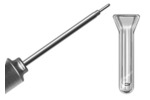- ▶
- Heaters/Source
- ▶
- Agilent Heaters and SensorsMass Spectrometry, Scientific Supplies & ManufacturingScientific Instrument Services 5973 Source Heater Tamper Resistant Allen Wrench 5973/5975 Quad Sensor 5985 Source Heater Assembly Agilent Interface Heater Assembly 5971 Interface Heater

- ▶
- Reference Material on InstrumentationArticle - A High Temperature Direct Probe for a Mass Spectrometer Design of a Direct Exposure Probe and Controller for use ona Hewlett-Packard 5989 Mass Spectrometer SIS AP1000 AutoProbe™ SIS AP2000 AutoProbe™ - Description of System HPP7: Direct Probe Electronics Console HPP7: Direct Probe for the Agilent (HP) 5973/5975 MSD HPP7: HP Direct Probe Application Notes HPP7: Installation Directions for the Direct Probe HPP7: Side Cover for the HP 5973 MSD HPP7: Support HPP7: Probe Inlet System for the Agilent (HP) 5973 and 5975 MSD with Automatic Indexed Stops HPP7: Theory of Operation of the Direct Probe and Probe Inlet System Direct Thermal Extraction Thermal Desorption Application Notes Environmental Thermal Desorption Application Notes Food Science Thermal Desorption Application Notes Forensic Thermal Desorption Application Notes GC Cryo-Trap Application Notes Headspace Application Notes Purge & Trap Thermal Desorption Application Notes Theory of Operation of the AutoDesorb® System AutoDesorb Notes for SIS Dealers Adsorbent Resin Application Notes Installation of the Short Path Thermal Desorption System on Agilent (HP) and Other GCs Installation of the Short Path Thermal Desorption System on a Varian 3400 GC AutoDesorb® System Development Team Thermal Desorption Applications and Reference Materials Installation of the Short Path Thermal Desorption System - TD5 Part I - Design & Operation of the Short Path ThermalDesorption System Installation Instructions for the Model 951 GC Cryo-Trap on the HP 5890 Series GC Installation Instructions for the Model 961 GC Cryo-Trap on the HP 5890 Series GC Operation of the Model 951/961 GC Cryo-Trap SIS GC Cryo Traps - Theory of Operation NIST/EPA/NIH Mass Spectral Enhancements - 1998 version (NIST98) SIMION 3D Ion Optics Class Mass Spectrometer Source Cleaning Methods MS Tip: Mass Spectrometer Source Cleaning Procedures Mass Spec Source Cleaning Procedures Micro-Mesh® Abrasive Sheets Research Papers Using New Era Syringe Pump Systems EI Positive Ion Spectra for Perfluorokerosene (PFK) Cap Liner Information How do I convert between fluid oz and milliliters? Which bottle material should I choose? Which bottle mouth should I choose? The Bottle Selection Guide CGA Connections for Gas Tanks Chemical Reaction Interface Mass Spectrometry (CRIMS)

- Probes
- LiteratureApplication Notes Adsorbent Resins Guide Mass Spec Tips SDS Sheets FAQ MS Calibration Compound Spectra Manuals MS Links/Labs/ Organizations MS Online Tools Flyers on Products/Services Scientific Supplies Catalog About Us NextAdvance Bullet Blender® Homogenizer Protocols Micro-Mesh® Literature Instrumentation Literature Agilent GC/MS Literature SIS News / E-Mail Newsletter NIST MS Database - Update Notifications

- ▶
- HPP7: HP Direct Probe Application NotesNo. 1 - Design of a Direct Exposure Probe and Controller for use on a Hewlett-Packard 5989 Mass Spectrometer No. 2 - A High Temperature Direct Probe for a Mass Spectrometer No. 44 - The Design of a New Direct Probe Inlet for a Mass Spectrometer No. 48 - Demonstration of Sensitivity Levels of Caffeine for a New Direct Probe and Inlet for the HP 5973 MSD No. 49 - Analysis of Cocaine Utilizing a New Direct Insertion Probe on a Hewlett Packard 5973 MSD No. 50 - The Analysis of Multiple Component Drug Samples Using a Direct Probe Interfaced to the HP 5973 MSD
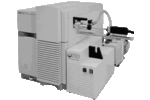
- Application NotesNote 103: EPA Method 325B, Novel Thermal Desorption Instrument Modification to Improve Sensitivity Note 102: Identification of Contaminants in Powdered Beverages by Direct Extraction Thermal Desorption GC/MS Note 101: Identification of Contaminants in Powdered Foods by Direct Extraction Thermal Desorption GC/MS Note 100: Volatile and Semi-Volatile Profile Comparison of Whole Versus Cracked Versus Dry Homogenized Barley Grains by Direct Thermal Extraction Note 99: Volatile and Semi-Volatile Profile Comparison of Whole vs. Dry Homogenized Wheat, Rye and Barley Grains by Direct Thermal Extraction GC/MS Note 98: Flavor and Aroma Profiles of Truffle Oils by Thermal Desorption GC/MS Note 97: Flavor Profiles of Imported and Domestic Beers by Purge & Trap Thermal Desorption GC/MS Note 96: Reducing Warping in Mass Spectrometer Filaments, with SISAlloy® Yttria/Rhenium Filaments Note 95: Detection of Explosives on Clothing Material by Direct and AirSampling Thermal Desorption GC/MS Note 94: Detection of Nepetalactone in the Nepeta Cataria Plant by Thermal Desorption GC/MS Note 93: Detection of Benzene in Carbonated Beverages with Purge & Trap Thermal Desorption GC/MS Note 92: Yttria Coated Mass Spectrometer Filaments Note 91: AutoProbe DEP Probe Tip Temperatures Note 90: An Automated MS Direct Probe for use in an Open Access Environment Note 89: Quantitation of Organics via a Mass Spectrometer Automated Direct Probe Note 88: Analysis of Silicone Contaminants on Electronic Components by Thermal Desorption GC-MS Note 87: Design and Development of an Automated Direct Probe for a Mass Spectrometer Note 86: Simulation of a Unique Cylindrical Quadrupole Mass Analyzer Using SIMION 7.0. Note 85: Replacing an Electron Multiplier in the Agilent (HP) 5973 MSD Note 84: Vacuum Pump Exhaust Filters - Charcoal Exhaust Traps Note 83: Vacuum Pump Exhaust Filters - Oil Mist Eliminators Note 82: Vacuum Pump Exhaust Filters Note 81: Rapid Bacterial Chemotaxonomy By DirectProbe/MSD Note 80: Design, Development and Testing of a Microprocessor ControlledAutomated Short Path Thermal Desorption Apparatus Note 79: Volatile Organic Compounds From Electron Beam Cured and Partially Electron Beam Cured Packaging Using Automated Short Path Thermal Desorption Note 78: A New Solution to Eliminate MS Down-Time With No-Tool-Changing of Analytical GC Columns Note 77: The Determination of Volatile Organic Compounds in VacuumSystem Components Note 76: Determination of the Sensitivity of a CRIMS System Note 75: An Apparatus for Sampling Volatile Organics From LivePlant Material Using Short Path Thermal Desorption Note 74: Examination of Source Design in Electrospray-TOF Using SIMION 3D Note 73: The Analysis of Perfumes and their Effect on Indoor Air Pollution Note 72: 1998 Version of the NIST/EPA/NIH Mass Spectral Library, NIST98 Note 71: Flavor Profile Determination of Rice Samples Using Shor tPath Thermal Desorption GC Methods Note 70: Application of SIMION 6.0 To a Study of the Finkelstein Ion Source: Part II Note 69: Application of SIMION 6.0 To a Study of the Finkelstein Ion Source: Part 1 Note 68: Use of a PC Plug-In UV-Vis Spectrometer To Monitor the Plasma Conditions In GC-CRIMS Note 67: Using Chemical Reaction Interface Mass Spectrometry (CRIMS) To Monitor Bacterial Transport In In Situ Bioremediation Note 66: Probe Tip Design For the Optimization of Direct Insertion Probe Performance Note 65: Determination of Ethylene by Adsorbent Trapping and Thermal Desorption - Gas Chromatography Note 64: Comparison of Various GC/MS Techniques For the Analysis of Black Pepper (Piper Nigrum) Note 63: Determination of Volatile and Semi-Volatile Organics in Printer Toners Using Thermal Desorption GC Techniques Note 62: Analysis of Polymer Samples Using a Direct Insertion Probe and EI Ionization Note 61: Analysis of Sugars Via a New DEP Probe Tip For Use With theDirect Probe On the HP5973 MSD Note 60: Programmable Temperature Ramping of Samples Analyzed ViaDirect Thermal Extraction GC/MS Note 59: Computer Modeling of a TOF Reflectron With Gridless Reflector Using SIMION 3D Note 58: Direct Probe Analysis and Identification of Multicomponent Pharmaceutical Samples via Electron Impact MS Note 57: Aroma Profiles of Lavandula species Note 56: Mass Spec Maintenance & Cleaning Utilizing Micro-Mesh® Abrasive Sheets Note 55: Seasonal Variation in Flower Volatiles Note 54: Identification of Volatile Organic Compounds in Office Products Note 53: SIMION 3D v6.0 Ion Optics Simulation Software Note 52: Computer Modeling of Ion Optics in Time-of-Flight mass Spectrometry Using SIMION 3D Note 51: Development and Characterization of a New Chemical Reaction Interface for the Detection of Nonradioisotopically Labeled Analytes Using Mass Spectrometry (CRIMS) Note 50: The Analysis of Multiple Component Drug Samples Using a Direct Probe Interfaced to the HP 5973 MSD Note 49: Analysis of Cocaine Utilizing a New Direct Insertion Probe on a Hewlett Packard 5973 MSD Note 48: Demonstration of Sensitivity Levels For the Detection of Caffeine Using a New Direct Probe and Inlet for the HP 5973 MSD Note 47: The Application Of SIMION 6.0 To Problems In Time-of-Flight Mass Spectrometry Note 46: Delayed Extraction and Laser Desorption: Time-lag Focusing and Beyond Note 45: Application of SIMION 6.0 to Filament Design for Mass Spectrometer Ionization Sources Note 44: The Design Of a New Direct Probe Inlet For a Mass Spectrometer Note 43: Volatile Organic Composition In Blueberries Note 42: The Influence of Pump Oil Purity on Roughing Pumps Note 41: Hydrocarbon Production in Pine by Direct Thermal Extraction Note 40: Comparison of Septa by Direct Thermal Extraction Note 39: Comparison of Sensitivity Of Headspace GC, Purge and Trap Thermal Desorption and Direct Thermal Extraction Techniques For Volatile Organics Note 38: A New Micro Cryo-Trap For Trapping Of Volatiles At the Front Of a GC Capillary Column Note 37: Volatile Organic Emissions from Automobile Tires Note 36: Identification Of Volatile Organic Compounds In a New Automobile Note 35: Volatile Organics Composition of Cranberries Note 34: Selection Of Thermal Desorption and Cryo-Trap Parameters In the Analysis Of Teas Note 33: Changes in Volatile Organic Composition in Milk Over Time Note 32: Selection and Use of Adsorbent Resins for Purge and Trap Thermal Desorption Applications Note 31: Volatile Organic Composition in Several Cultivars of Peaches Note 30: Comparison Of Cooking Oils By Direct Thermal Extraction and Purge and Trap GC/MS Note 29: Analysis Of Volatile Organics In Oil Base Paints By Automated Headspace Sampling and GC Cryo-Focusing Note 28: Analysis Of Volatile Organics In Latex Paints By Automated Headspace Sampling and GC Cryo-Focusing Note 27: Analysis of Volatile Organics In Soils By Automated Headspace GC Note 26: Volatile Organics Present in Recycled Air Aboard a Commercial Airliner Note 25: Flavor and Aroma in Natural Bee Honey Note 24: Selection of GC Guard Columns For Use With the GC Cryo-Trap Note 23: Frangrance Qualities in Colognes Note 22: Comparison Of Volatile Compounds In Latex Paints Note 21: Detection and Identification Of Volatile and Semi-Volatile Organics In Synthetic Polymers Used In Food and Pharmaceutical Packaging Note 20: Using Direct Thermal Desorption to Assess the Potential Pool of Styrene and 4-Phenylcyclohexene In Latex-Backed Carpets Note 19: A New Programmable Cryo-Cooling/Heating Trap for the Cryo-Focusing of Volatiles and Semi-Volatiles at the Head of GC Capillary Columns Note 18: Determination of Volatile Organic Compounds In Mushrooms Note 17: Identification of Volatile Organics in Wines Over Time Note 16: Analysis of Indoor Air and Sources of Indoor Air Contamination by Thermal Desorption Note 14: Identification of Volatiles and Semi-Volatiles In Carbonated Colas Note 13: Identification and Quantification of Semi-Volatiles In Soil Using Direct Thermal Desorption Note 12: Identification of the Volatile and Semi-Volatile Organics In Chewing Gums By Direct Thermal Desorption Note 11: Flavor/Fragrance Profiles of Instant and Ground Coffees By Short Path Thermal Desorption Note 10: Quantification of Naphthalene In a Contaminated Pharmaceutical Product By Short Path Thermal Desorption Note 9: Methodologies For the Quantification Of Purge and Trap Thermal Desorption and Direct Thermal Desorption Analyses Note 8: Detection of Volatile Organic Compounds In Liquids Utilizing the Short Path Thermal Desorption System Note 7: Chemical Residue Analysis of Pharmaceuticals Using The Short Path Thermal Desorption System Note 6: Direct Thermal Analysis of Plastic Food Wraps Using the Short Path Thermal Desorption System Note 5: Direct Thermal Analysis Using the Short Path Thermal Desorption System Note 4: Direct Analysis of Spices and Coffee Note 3: Indoor Air Pollution Note 2: Detection of Arson Accelerants Using Dynamic Headspace with Tenax® Cartridges Thermal Desorption and Cryofocusing Note 1: Determination of Off-Odors and Other Volatile Organics In Food Packaging Films By Direct Thermal Analysis-GC-MS Tech No. "A" Note 14: Elimination of "Memory" Peaks in Thermal Desorption Improving Sensitivity in the H.P. 5971 MSD and Other Mass Spectrometers - Part I of II Improving Sensitivity in the H.P. 5971 MSD and Other Mass Spectrometers- Part II of II Adsorbent Resins Guide Development and Field Tests of an Automated Pyrolysis Insert for Gas Chromatography. Hydrocarbon Production in Pine by Direct Thermal Extraction A New Micro Cryo-Trap for the Trapping of Volatiles at the Front of a GC Capillary (019P) - Comparison of Septa by Direct Thermal Extraction Volatile Organic Composition in Blueberry Identification of Volatile Organic Compounds in Office Products Detection and Indentification of Volatiles in Oil Base Paintsby Headspace GC with On Column Cryo-Trapping Evaluation of Septa Using a Direct Thermal Extraction Technique INFLUENCE OF STORAGE ON BLUEBERRY VOLATILES Selection of Thermal Desorption and Cryo-Trap Parameters in the Analysis of Teas Redesign and Performance of a Diffusion Based Solvent Removal Interface for LC/MS The Design of a New Direct Probe Inlet for a Mass Spectrometer Analytes Using Mass Spectrometry (CRIMS) Application of SIMION 6.0 to Filament Design for Mass Spectrometer Ionization Sources A Student Guide for SIMION Modeling Software Application of SIMION 6.0 to Problems in Time-of-flight Mass Spectrometry Comparison of Sensitivity of Headspace GC, Purge and TrapThermal Desorption and Direct Thermal Extraction Techniques forVolatile Organics The Influence of Pump Oil Purity on Roughing Pumps Analysis of Motor Oils Using Thermal Desorption-Gas Chromatography-Mass Spectrometry IDENTIFICATION OF VOLATILE ORGANIC COMPOUNDS IN PAPER PRODUCTS Computer Modeling of Ion Optics in Time-of-Flight mass Spectrometry using SIMION 3D Seasonal Variation in Flower Volatiles Development of and Automated Microprocessor Controlled Gas chromatograph Fraction Collector / Olfactometer Delayed Extraction and Laser Desorption: Time-lag Focusing and Beyond A New Micro Cryo-Trap for the Trapping of Volatiles at the Front of a GC Column Design of a Microprocessor Controlled Short Path Thermal Desorption Autosampler Computer Modeling of Ion Optics in Time-of-Flight Mass Spectrometry Using SIMION 3D Thermal Desorption Instrumentation for Characterization of Odors and Flavors

- ▶
- No. 48 - Demonstration of Sensitivity Levels of Caffeine for a New Direct Probe and Inlet for the HP 5973 MSD (This Page)
1999
INTRODUCTION
The direct probe has routinely been used for mass spectrometer sample analysis for over 30 years. The technique has the advantage of being very fast and permits the analysis or screening of a large number of samples in a normal work day. It permits the analysis of many samples which can not be chromatographed or analyzed by other techniques. However, the technique can not separate or resolve more than two or three analytes in a sample. Samples must be relatively clean or the analyte of interest must be the major component in the sample. Sample clean up can often be accomplished by a quick solvent extraction or the use of a solid phase extraction cartridge. The direct probe technique has sensitivity limitations due to the lack of resolution of the sample analytes as compared to GC sample analysis with very narrow peak widths for each of the analytes. However, the short analysis times of the direct probe technique make it the method of choice for drug screening and quality control sample analysis in the forensic and pharmaceutical industry.
Samples are normally introduced into the HP MSD instruments through a gas chromatograph via the GC/MS heated interface on the right side of the MSD. A direct probe was not available for the 5971 and 5972 instruments. This was due to the design of the MSD instruments and the use of the GC/MS transfer line to indirectly heat the MSD source. The new Hewlet Packard 5973 MSD utilizes a cartridge heater and heater block to directly heat the mass spec source. This now permits the use of a direct probe. SIS has designed and built a direct probe and probe inlet system for the HP 5973 (Figure 1). This system mounts onto the GC/MS transfer line port and uses an indexed probe introduction guide to permit the introduction of a direct (solids) probe into the MSD source.
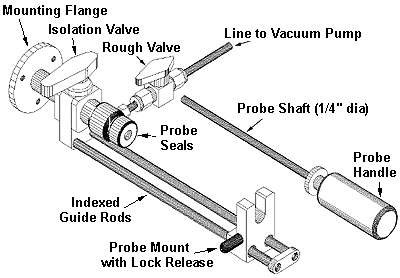
Figure # 1 - Components of the HP 5973 Probe Inlet System
The purpose of this study is to demonstrate the use of the new HP 5973 direct probe and probe inlet system. Analysis of a caffeine standard sample illustrates the use of the direct heated probe to determine the levels of sensitivity which can be achieved with this technique.
Experimental
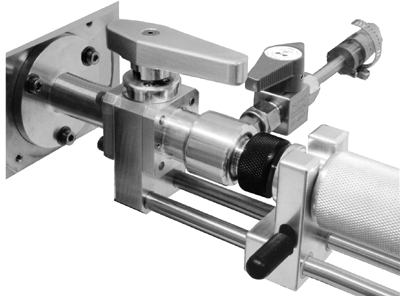
Figure # 2 - HP Probe Inlet System Mounted On the HP 5973 MSD
The SIS Direct Probe Inlet and Probe (Figure 1), is designed to mount on the H.P. 5973 MSD. In order to install the system, it is necessary to first remove the gas chromatograph and the heated GC/MS interface from the MSD. The probe inlet system then attaches to the side of the MSD using the same three mounting holes which held the GC/MS interface onto the side of the MSD (Figure # 2). The probe inlet system (Figure 1) consists of a ¼ turn ball isolation valve to permit the introduction of the probe into the mass spec, a ¼ turn rough pumping valve attached to an Edwards 1.5 rough pump, a dual PTFE sealing system to provide long life vacuum seals to the probe, and an indexed dual guide rod introduction system. This guide rod system is indexed at three positions to permit the easy introduction of the probe into the vacuum system with automatic stops at the first seal position, the second seal position and 1 cm distance from the source (cooling position). These automatic stops enable the accurate positioning of the probe, eliminates scoring of the probe rod due to closing the ball valve on the probe rod and minimizes the accidental venting of the mass spec by inadvertently pulling the probe out past the vacuum seals before closing the isolation valve. The mass spec probe can be heated ballistically up to 450 degrees C at a ramp rate in excess of 500 degrees per minute. The probe can also be temperature programmed for slower heating applications. The probe shaft is only ¼" in diameter and the probe handle is 1.25" in diameter. This provides for ease of handling during sample introduction. The probe uses flared glass sample vials 1.7mm diameter by 12.75 mm long for sample containment. The sample vial is then inserted into the tip of the probe where it is held in place by a small spring.
Pure anhydrous Caffeine (Sigma Chemical Company, St. Louis, MO) was used for the following analysis via the direct probe technique. A solution of caffeine was prepared at a concentration of 10 mg/liter (10 ng/ul) in Methanol. This solution was injected into the direct probe sample vials using a GC syringe to prepare sample vials with the following amounts of caffeine:.
Sample Sample Volume Amount of Caffeine
1 0.5 ul 5.0 ng
2 1.0 ul 10.0 ng
3 2.0 ul 20.0 ng
4 3.0 ul 30.0 ngAfter sample injection, the methanol solvent in each of the sample vials was allowed to evaporate to dryness before analyzing any of the samples. This was accomplished in about 15 minutes by heating the sample vials in a sample vial block to 60 degrees C.
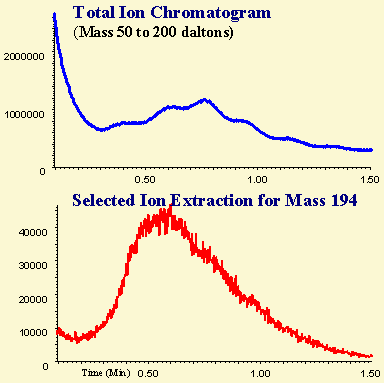
Figure # 3 - Direct Probe Analysis of 10 ng Cafeine
The HP 5973 MSD was operated in the EI mode and was scanned from 50 to 200 daltons at 1 scan per second. The mass spec source temperature was set at 250 and the quads at 150 degrees C. Each direct probe sample was inserted into the mass spec probe and inserted through the vacuum lock system of the probe inlet into the mass spec source of the HP 5973 MSD. Each sample was then heated ballistically to 250 degrees (at > 500 degrees per minute), and the mass spec was scanned to analyze the thermally extracted sample. The total analysis time was 1.5 minutes per sample. After the sample analysis was complete, the total ion chromatogram (Figure 3 - top) was viewed using the ChemStation data analysis module and then the sample was then further analyzed using the selected ion extraction function of the ChemStation software for the 194 ion of caffeine (Figure 3 - bottom). The average mass spectrum was then taken over a 0.10 minute time range at the highest intensity range of the resulting peak and the background from the front of this broad peak was subracted.
Results
The total ion chromatogram for a 10 ng sample of Caffeine is shown in the top drawing of Figure 3. The selected ion chromatogram for mass 194 was then determined utilizing the ChemStation software (bottom drawing of Figure 3). The result was a near gaussean shaped peak with tailing on the back side an a peak half width of about 0.40 minutes. The 194 ions are part of the total ions present in the sample as shown in the top drawing of Figure 3. The other ions consisted of other background materials including several hydrocarbons. This use of the selected ion program in the ChemStation software is a very useful tool to search for a particular analyte in a direct probe sample, and will enable the user to accurately analyze the most intense section of the total mass scans and also select an area from which to subtract the background. The use of background subtraction is quite useful in order to clean up a mass spectrum for more accurate sample identification using standard mass spec libraries.
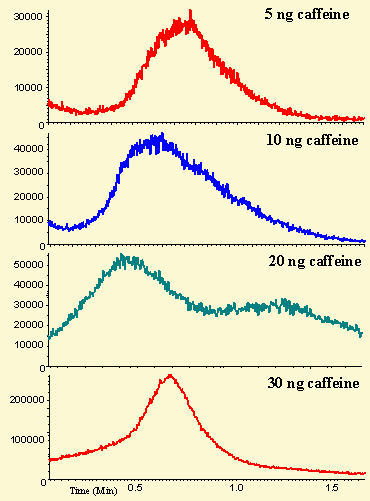
Figure # 4 - Direct Probe Analysis of Caffeine Sensitivity Study (Selected Ion Extraction - 194)
The results of the selected ion chromatograms for each of the 4 sample sizes of the caffeine samples analyzed are shown in Figure 4. Sample sizes down to 5.0 ng were easily detected and identified using the direct probe technique. However, at the lower concentrations, the signal became quite weak and the signal to noise ratio decreased. The mass spectrum was taken by analyzing the average of a 0.10 minute time at the top of each peak in Figure 4 and the background was subtracted from the front of each peak utilizing the ChemStation software. The results are shown in Figure 5. Caffeine has a molecular weight of 194 and produces a molecular ion at mass 194. The minor ions at 109, 82, 67, 55, 137 and 165 also originate from the caffeine. Although the Caffeine is easily detected in all the samples, it is less obvious in the 5.0 ng sample due to the hydrocarbon background. Detection of caffeine below 5.0 ng would be more difficult but could be achieved by scanning a narrow mass range (i.e 150 to 200 daltons) or by using the mass spec in the selected ion mode (SIM).
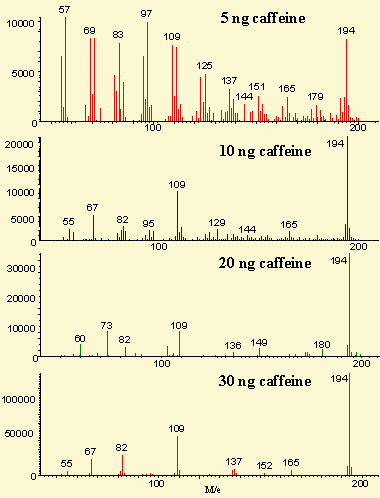
Figure # 5 - Mass Spectra of Caffeine via Direct Probe Sensitivity Study (50 to 200 daltons)
Additional studies have recently been done, operating the mass spec source at 350 degrees C and maximizing the mass spec scan rate for optimum sensitivity. As a result, we have been able to analyze caffeine samples down to 1 nanogram size.
Conclusion
The new SIS direct probe and probe inlet system has proved to be a useful addition to the new Hewlet Packard 5973 MSD. The probe inlet system permits the direct introduction of the probe through what is normally the GC/MS interface line on the MSD. The indexed probe introduction system permits the easy insertion of the probe without the chance of inadvertently venting of the mass spec or scoring of the mass spec probe shaft. Samples were analyzed in less than 1.5 minutes with this technique. The direct probe analysis technique has proved to be a very sensitive technique for solid sample analysis with detection levels of 5 to 10 ng of Caffeine injected. The broad peak width (0.4 minute peak half width) is quite large as compared to a GC analysis and contributes to the loss in sensitivity as compared to conventional GC analysis where peak widths are normally less than 5 seconds. However, the outstanding sensitivity of the new HP 5973 MSD enables the direct probe analysis of sample levels comparable to many GC samples analyzed via the older 5971 MSD instruments. The direct probe introduction system interfaced to the HP 5973 will be a valuable technique for the analysis of many samples, where fast sample analysis is required such as in drug screening, for the quality control analysis of samples and for the analysis of samples which can not be chromatographed.


